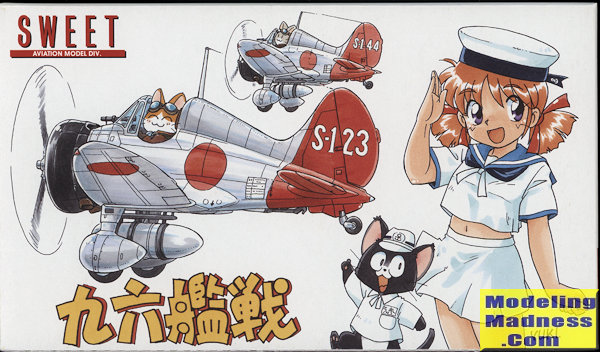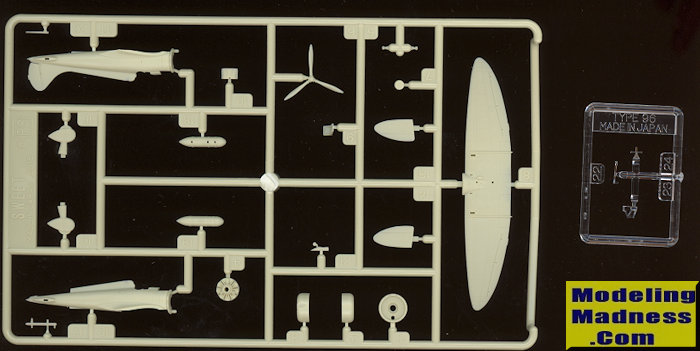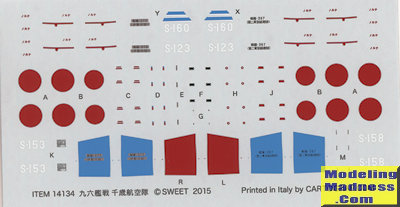
Sweet 1/144 A5M4 'Chitose Flying Group'
| KIT #: | 14134 |
| PRICE: | 1600 yen (about $14.00) from www.hlj.com |
| DECALS: | Four options |
| REVIEWER: | Scott Van Aken |
| NOTES: | Two complete kits |

| HISTORY |
The aircraft entered service in early 1937, soon seeing action in pitched aerial battles at the start of the Second Sino-Japanese War, including air-to-air battles with the Republic of China Air Force's Boeing P-26C Model 281 "Peashooters" in what was the world's first-ever aerial dogfighting and kills between monoplane fighters built of mostly metal.
Chinese Nationalist pilots, primarily flying the Curtiss Hawk III, put up a valiant fight against the Japanese, but the A5M was the better of almost every fighter aircraft it encountered. Though armed with only a pair of 7.7 mm machine-guns, the new fighter proved effective and damage-tolerant, with excellent maneuverability and robust construction. Later on A5M's also provided much-needed escorts for the then-modern but vulnerable Mitsubishi G3M bombers.
The Mitsubishi team continued to improve the A5M, working through versions until the final A5M4, which carried an external underside drop tank to provide fuel for extended range.
The A5M's most competitive adversary in the air was the Polikarpov I-16, a fast and heavily armed fighter flown by both Chinese Air Force regulars and Soviet volunteers. Fierce air battles in 1938, especially on 18 February and 29 April, ranked among the largest air battles ever fought at the time. The battle of 29 April saw 67 Polikarpov fighters (31 I-16s and 36 I-15 bis) against 18 G3Ms escorted by 27 A5Ms. Each side claimed victory: the Chinese/Soviet side claimed 21 Japanese aircraft (11 fighters and 10 bombers) shot down with 50 Japanese airmen killed and two captured having bailed out while losing 12 aircraft and 5 pilots killed; the Japanese claimed they lost only two G3Ms and two A5Ms shot down with no less than 40 Chinese planes shot down.
104 A5M aircraft were modified to accommodate a two-seater cockpit. This version, used for pilot training, was dubbed the A5M4-K. K version planes continued to be used for pilot training long after standard A5Ms left front-line service.
Almost all A5Ms had open cockpits. A closed cockpit was tried but found little favor among Navy aviators. All had fixed, non-retractable undercarriage. Wheel spats were a feature of standard fighters but not training planes.
The Flying Tigers encountered the Type 96, although not officially, and one was shot down at Mingaladon airfield, Burma on 29 January 1942.
Some A5Ms remained in service at the end of 1941 when the United States entered World War II in the Pacific. US intelligence sources believed the A5M still served as Japan's primary Navy fighter, when in fact the A6M 'Zero' had replaced it on first-line aircraft carriers and with the Tainan Kōkūtai in Taiwan. Other Japanese carriers and Kōkūtai (air groups) continued to use the A5M until production of the Zero caught up with demand. The last combat actions with the A5M as a fighter took place at the Battle of the Coral Sea on 7 May 1942, when two A5Ms and four A6Ms of the Japanese carrier Shōhō fought against US planes that sank their carrier.
In the closing months of the war most remaining A5M airframes were used for kamikaze attacks.
| THE KIT |
 I've always liked Sweet kits ever since I had to the chance to build one of their first kits, a Hawker Hurricane. What really struck me then is that there was actually something of a cockpit and the detailing was quite impressive, especially for kits of this size. This is all true today as ell with some bits, such as the separate exhaust ports, being tiny beyond belief. The cockpit does have a seat, though not much else. A nicely molded engine fits in between two cowling halves, though it is split horizontally along a panel line.
I've always liked Sweet kits ever since I had to the chance to build one of their first kits, a Hawker Hurricane. What really struck me then is that there was actually something of a cockpit and the detailing was quite impressive, especially for kits of this size. This is all true today as ell with some bits, such as the separate exhaust ports, being tiny beyond belief. The cockpit does have a seat, though not much else. A nicely molded engine fits in between two cowling halves, though it is split horizontally along a panel line.
A single piece wing is provided and the instructions would have to file down an overly thick trim tab. This variant carried a centerline tank which is provided along with its mount. Complete wheel/spat assemblies plug into the lower wing as does a tail wheel piece and a tail hook. One the upper side, a radio mast and gun sight are attached. The windscreen is nicely molded as well. Instructions indicate that some planes have the radio mast removed, but the markings guide shows all planes with this feature.
 What sets this kit apart from the others are the markings. In this case, the four options are from the Chitose Flying Group. Three of the options are from when the group was based at Chitose air base from December 1940-May 1941. These airplanes all have red tail sections along with board fuselage bands in either red or blue. The fourth option is without the fuselage bands when station at Rabaul from Jan-March 1942. Stencils are also included.
What sets this kit apart from the others are the markings. In this case, the four options are from the Chitose Flying Group. Three of the options are from when the group was based at Chitose air base from December 1940-May 1941. These airplanes all have red tail sections along with board fuselage bands in either red or blue. The fourth option is without the fuselage bands when station at Rabaul from Jan-March 1942. Stencils are also included.
| CONCLUSIONS |
Another superb offering from Sweet and one that will make into very nice models for those who are lacking in display space or just like 1/144 fighters. There have been at least three boxings of this airplane from Sweet and if history repeats, there will be several more.
| REFERENCES |
https://en.wikipedia.org/wiki/Mitsubishi_A5M
March 2016
Copyright ModelingMadness.com Thanks to www.hlj.com for the preview kit. You can get yours today at this link. If you would like your product reviewed fairly and fairly quickly, please contactthe editor or see other details in the